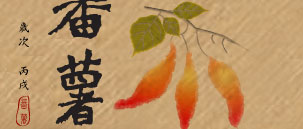





|
The preventing and cure of the Insect
|
|
| |
There are more than sixty species recorded in Taiwan, and among them about ten are familiar to people. Because of the strong recovering ability of sweet potato, leaf-eating insects are not seriously harmful to it. The primary insects that constitute a threat for production are Sweet Potato weevil, Sweet potato vine borer, and Sweet potato leaf beetle. Their botany is summarized individually as follows:
|
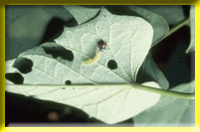
To appropriately release predacious natural enemy can effectively prevent from and cure insect harm.
|
|
|
|
| |
Sweet Potato weevil (scientific name :Cylas formicarius)
|
|
| |
There are seven to eight generations in a year. And the most intensive periods of breeding are from August to next January. The most seriously harmed sweet potato is harvested from November to next March, and it is planted from May to September. The next seriously harmed sweet potato is planted from October to November and harvested in next May. The soil of planting is easier to be harmed from Sweet Potato weevil. They are individually the soil of clay that is easy to chap and the soil of silt. And the second is the soil of sand.
|
|
|
| |
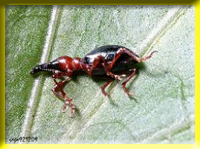
If someone disturbs the Sweet Potato weevil, it will pretend dead in the ground.
|
The imago is mostly groundling between leaf and bine gnawing the root tuber or leafstalk. There is a habit to pretend dead. The nits were born in the main base of the bine or inside the cutis of root tuber, and the mature budworms were turned into pupas in the harmful parts. The budworms eat roots or root tuber, and it wormed and ate in main bine or root tuber. The harmful parts are in brown, lignified, effluvial, and cannot be cooked. |
|
|
| |
|
| |
Sweet potato leaf beetle (scientific name :Colasposoma auripenne Motschulsky)
|
|
|
| |
There are two to three generations in a year. They usually appear both from March to April and from July to August. Imagoes are the primary harm for spears of sweet potatoes. They eat leaves, stems and make the top of spears broken easily. The eaten leaves are in irregular aperture shape. Nits were born on earth surface. The mature budworms were turned into pupas in the earth. The budworms eat roots or root tuber which formed irregular concavity on the cuticle. Though it would not eat in the inner of root tuber, but it will affect the value of products. This kind of beetle is harmful for the harvest in fall.
|

The budworms of Sweet potato leaf beetle wormed in the earth and eating the cutis of sweet potatoes.
|
|
|
|
| |
Sweet potato vine borer (scientific name :Omphisa anastomosalis)
|
|
|
| |
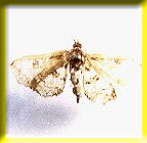
Sweet potato vine borer is harmful to the main bine
|
There are five to seven generations in a year. The spears planting from June to July are more harmful. Imagoes stay quiet between stems and bines in daytime and become active at night. Nits were born on the leaves. The budworms wormed and ate in main bine, and usually one bine one budworms. The mature budworms made pupas in the main bine. The harmful parts are easily broken while turning over the bine, and expand to lignification. |
|
|
| |
|
| |
Witches' broom (scientific name :Mycoplasma-like organism)
|
|
| |
|
|
|
| |
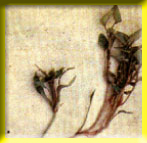
The infected plant from Witches' broom appears small stem, atrophied mat, small leaf mat.
|
This kind of disease is brought about imitation fungus plasmid, spread by root tubers, spears, and medium of insects. The high breeding of these insects is from April to June and the ability of spreading virus is also very strong. Most of the disease happened in Xin-Zhu coastal area, Peng-Hu, Jin-men, Ping-Dong, and Liu-Chiu. The characteristics of the disease are smaller, twisted leaf, shorter between joint and joint, mating axillary bud, flower-ware turns into leafy, shorted trunk turns into mat. The main prevention and cure is healthy spears, hygiene between fields, and clean off the medium of insects. |
|
|
|
| |
The other leaf-eating insects
|
|
|
| |
The primary of the insects are Tobacco Cutworm (scientific name: Spodoptera litura Fabricius), Ochyrotica concursa Walsinghan(scientific name ), Alucita niveodactyla Pagenstecher(scientific name ), Brachmia macroscopa Mryrick(scientific name ), Sweet potato leaf miner(scientific name :Bedellia ferenodes Meyrick), Paraearctic sweet potato hornworm(scientific name :Agrius convolvuli), Metriona cicumdata(scientific name ), Bemisia argentifolii Bellows & Perring (scientific name ), Green peach aphid(scientific name :Myzus persicae) and so on. It needs to be prevented and cured only when the area of harm is over 30%. |
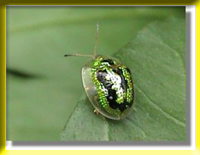
Leaf Beetles (scientific name :Cassida cicumdata) are easy to be observed on the sweet potato fields. Its food is the leaf of sweet potato.
|
|
|
|
| |
The primary insects’s comprehensive prevention and cure
|
|
|
| |
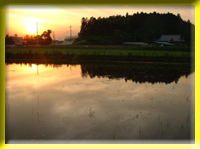
The best way to comprehensively prevention and cure the insects is the rotation of paddy field.
|
1. The crop rotation: It is better to be rotated with paddy field.
2. One week before the planting and after, they need to immerse in water for 2 to 3 days.
3. The dip treatment of spears and use the harmless spears.
4. The hygiene between fields: To get rid of the root tubers which are infected plant and the middle host which are the plant of Convolvulaceae. They are Ipomoea cairica, Ipomoea aquatica Forsk. [Ipomoea reptans (L.) Poir.], Ipomoea pescaprae (L.) Sweet. Subsp. Brasiliensis.
5. To strengthen banking up with earth and irrigating.
6. Before planting, mix and toss active pharmaceutical ingredient on the plot of land then planting the spears.
7. After planting and before banking up with earth, spread active pharmaceutical ingredient again.
8. At the whole breeding, each land has set up four pheromone trapping to trap and kill the Sweet Potato weevil.
|
|
|
| |
| |
|
| |
|
|
|
